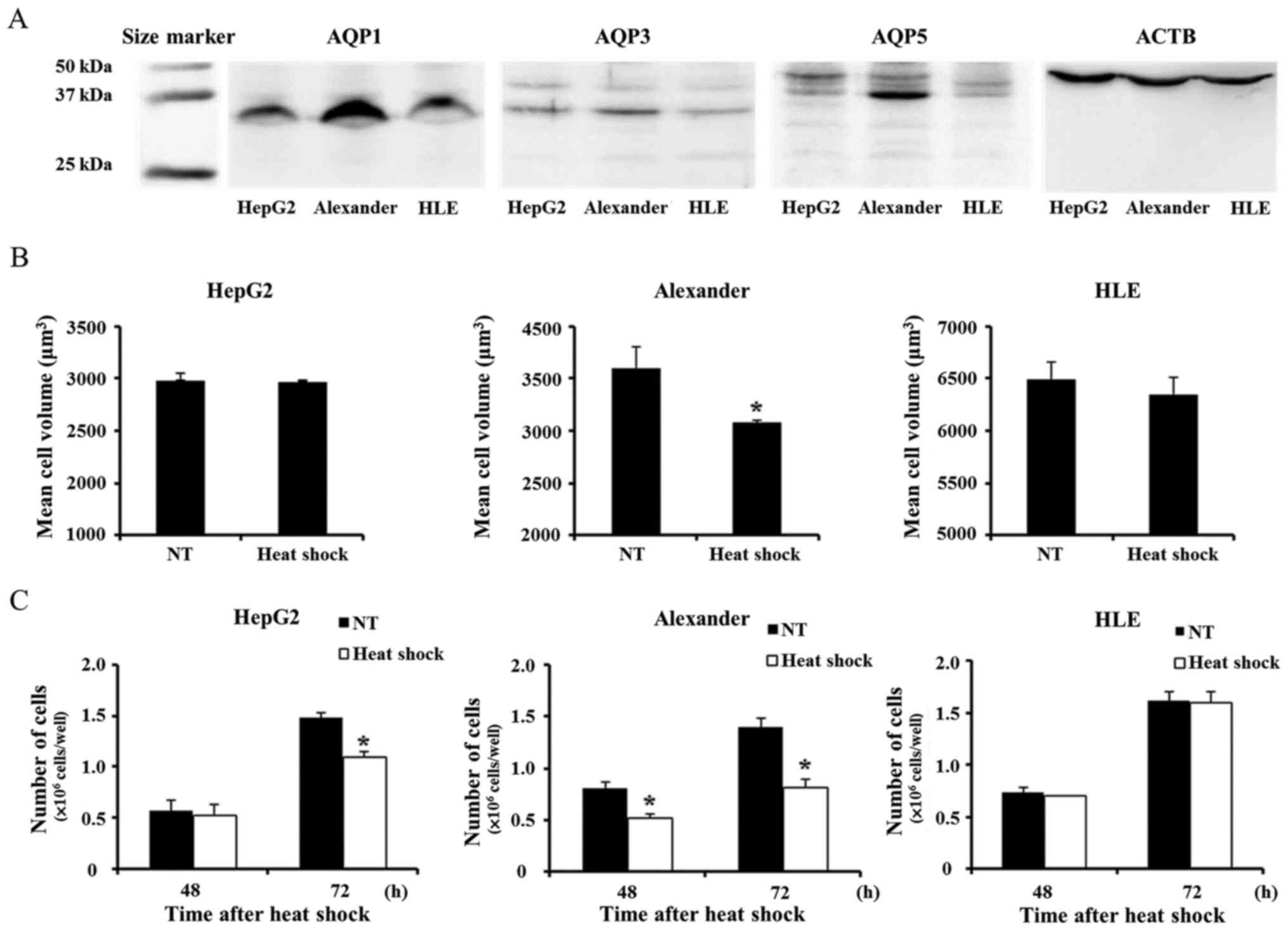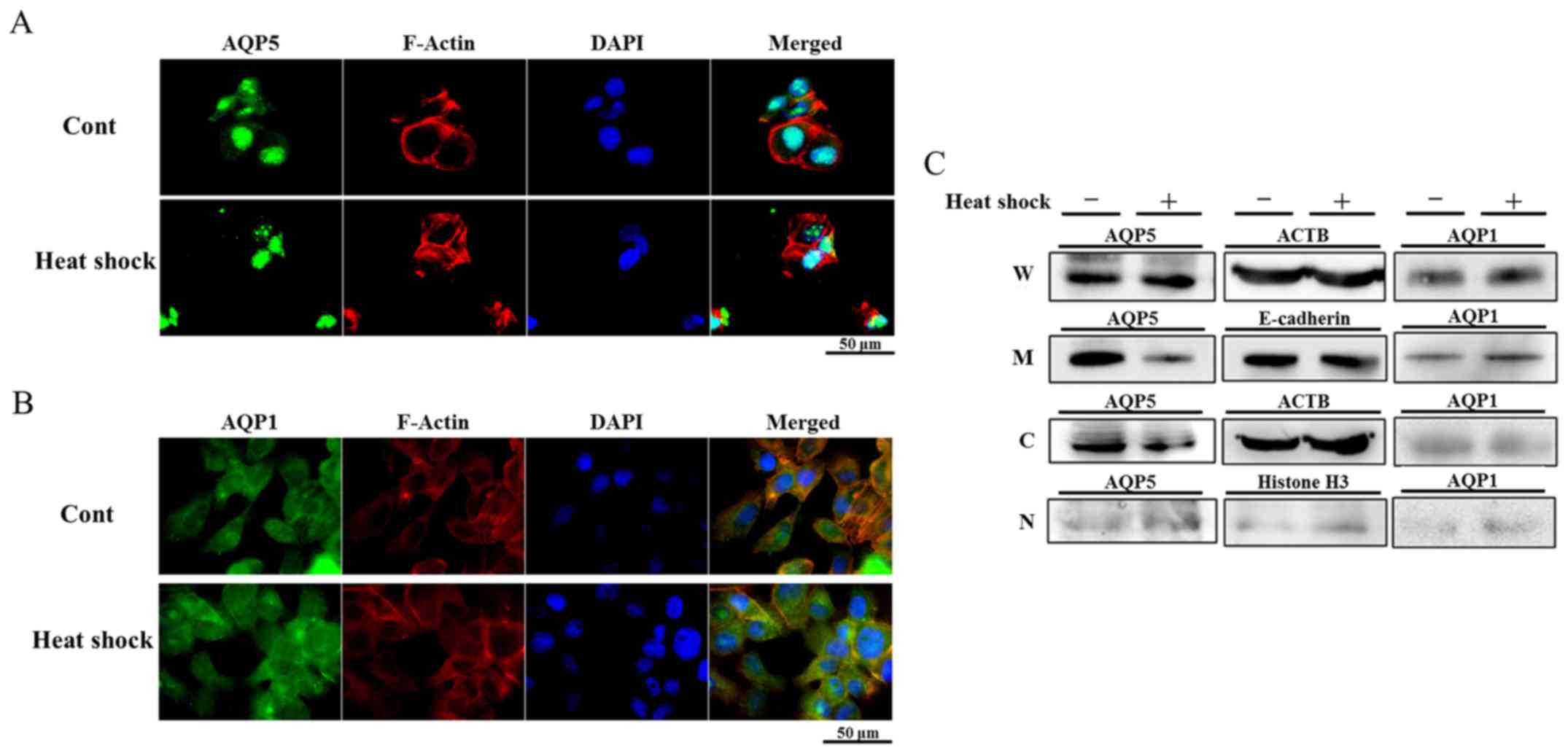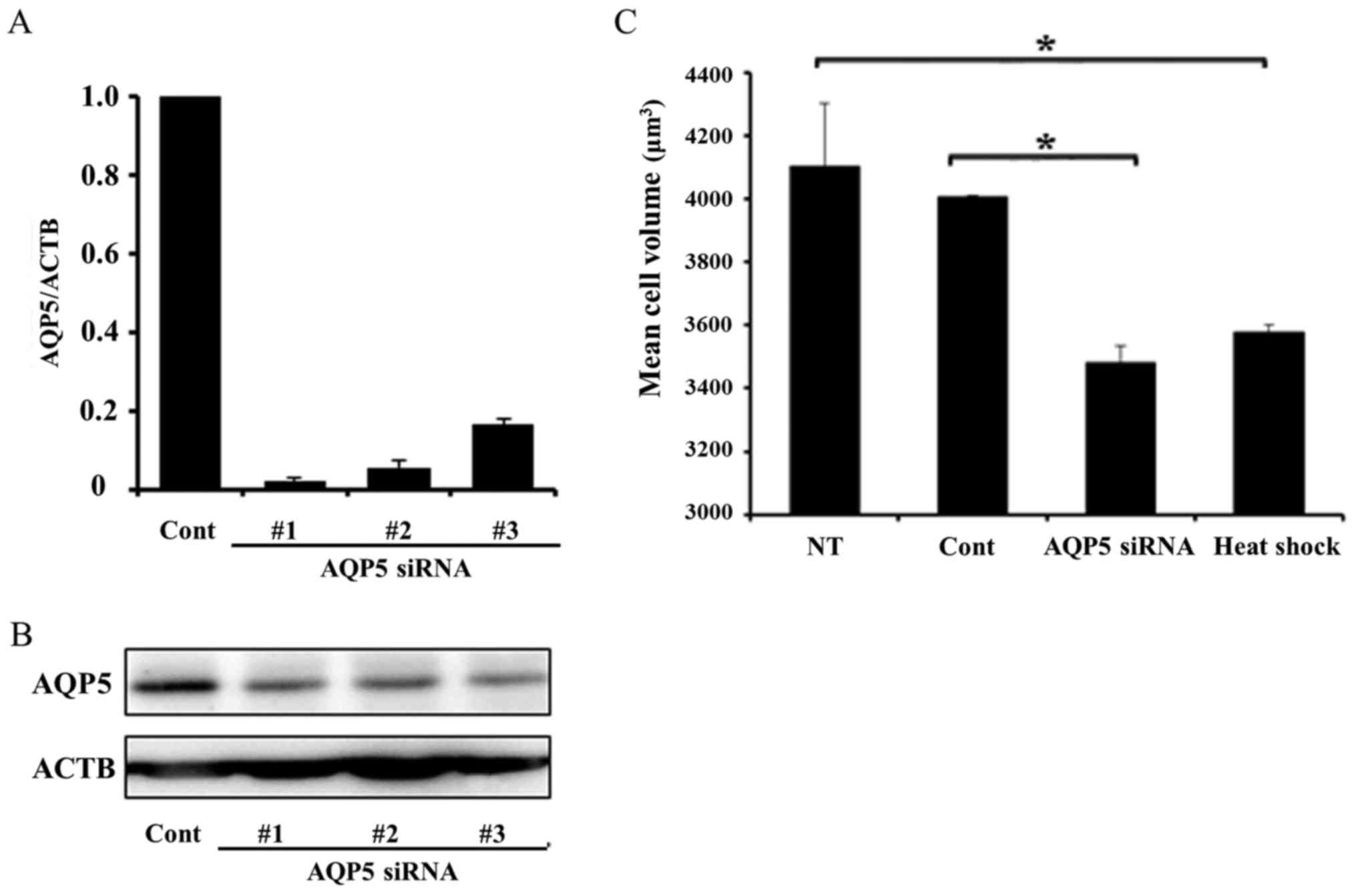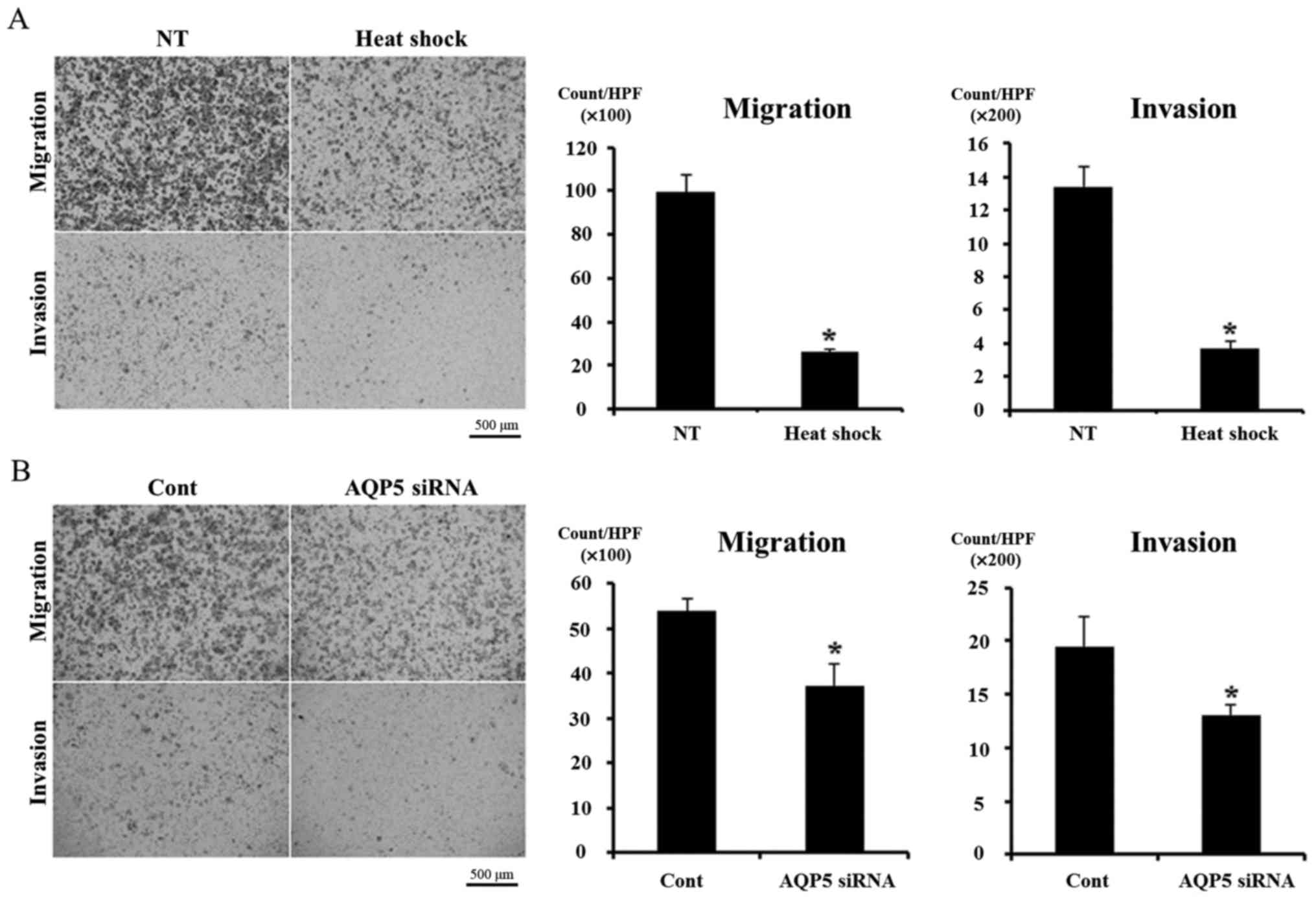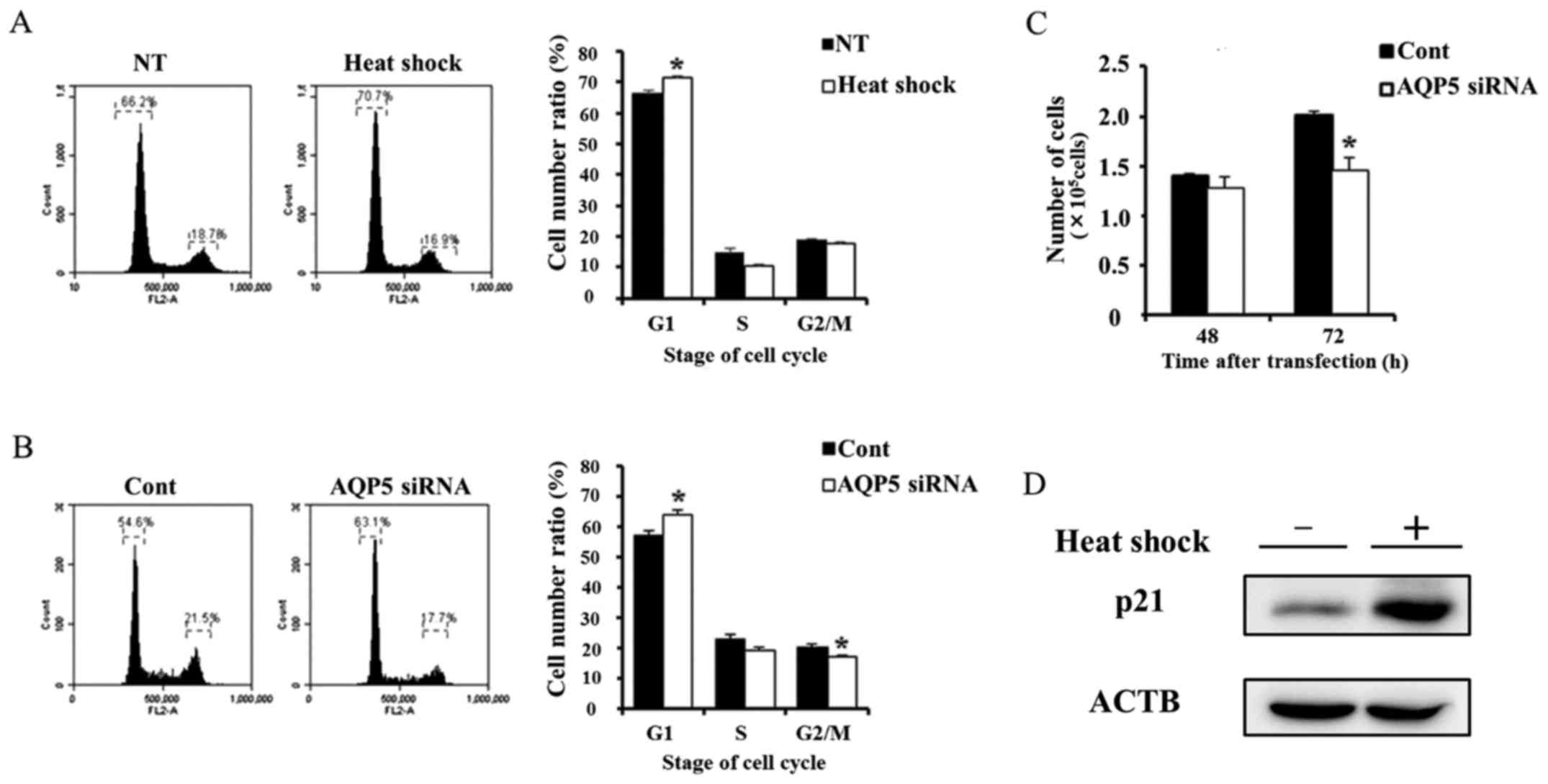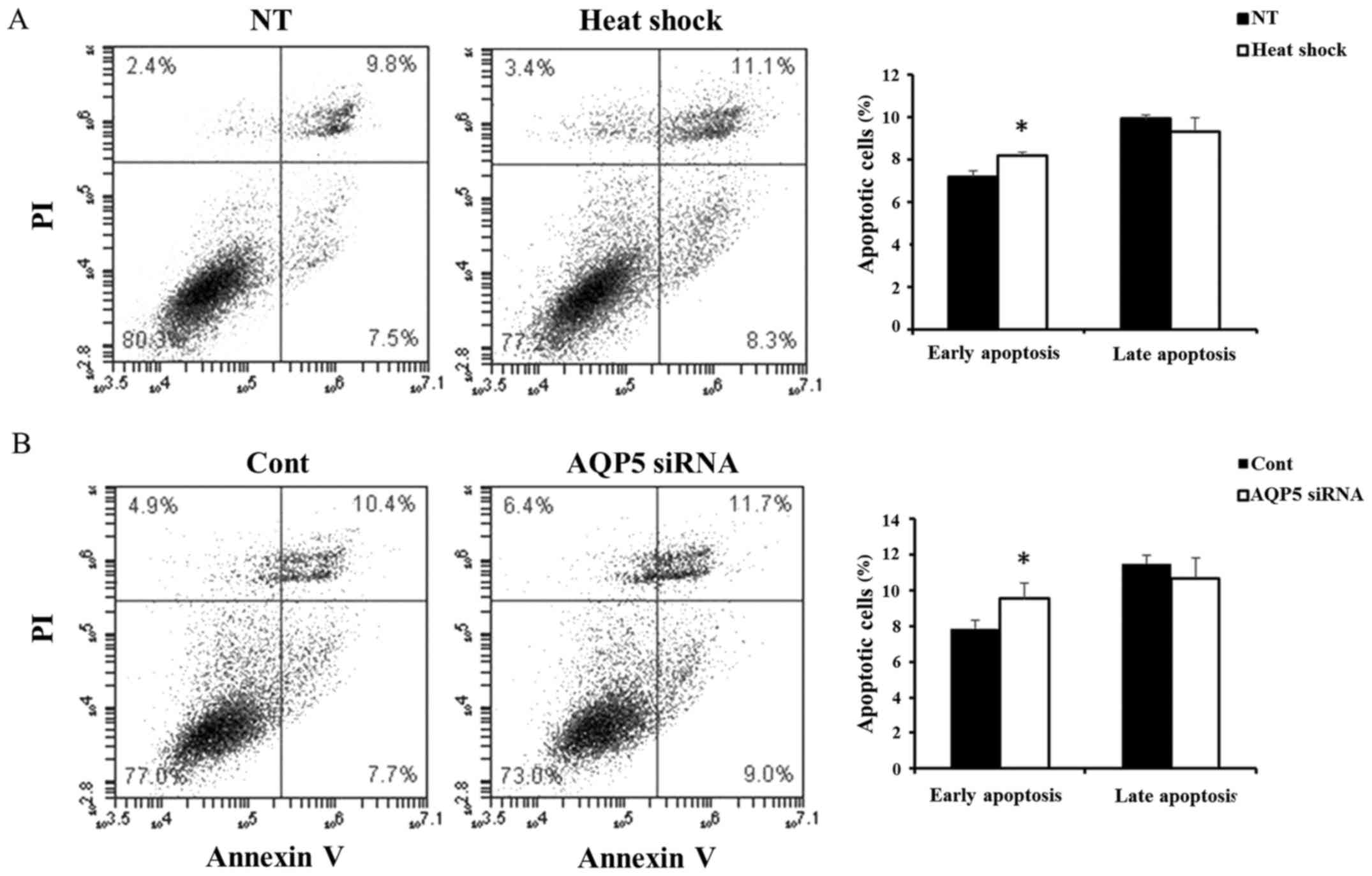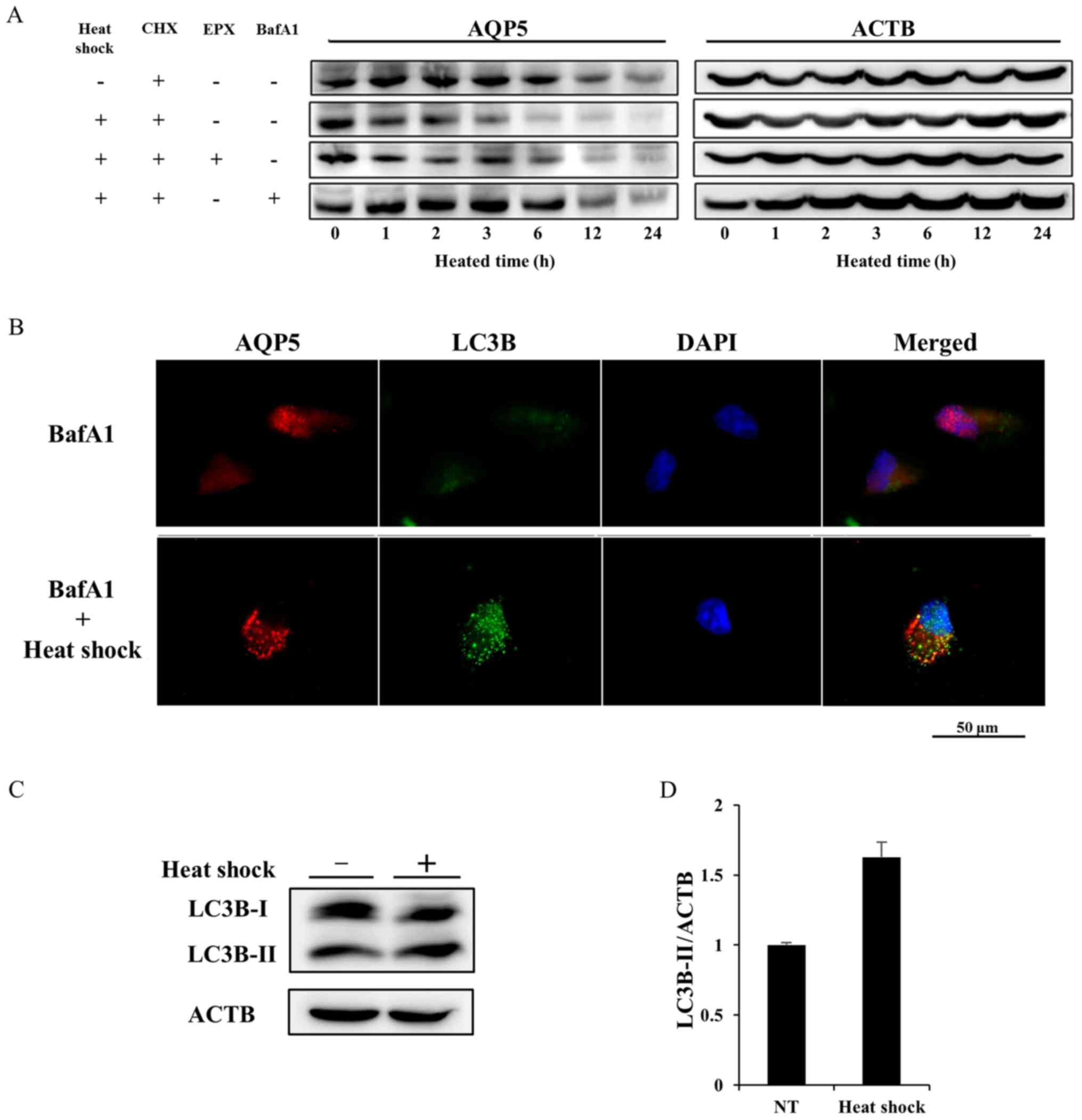Heat shock exerts anticancer effects on liver cancer via autophagic degradation of aquaporin 5
- Authors:
- Published online on: March 29, 2017 https://doi.org/10.3892/ijo.2017.3940
- Pages: 1857-1867
Abstract
Introduction
Liver cancer is the fifth most common malignancy and a major cause of mortality and morbidity worldwide (1). Although treatments directed at liver cancer patients have advanced and the molecular mechanisms of carcinogenesis have been elucidated, the prognosis of liver cancer patients has remained poor (2,3). Therefore, the molecular characteristics of liver cancer need to be examined in more detail and new therapeutic methods developed.
Hyperthermia (HT) is a cancer therapy that has been used since ancient times. Although HT may be administered alone, it is frequently used in combination with other therapies including chemotherapy and radiation therapy. HT has been distinguished into local, regional, and whole body HT. Among currently available liver cancer therapies, ablation therapies, which involve local HT including radiofrequency and microwave ablation, have been widely used and are regarded as standard treatments (4). Moreover, the effectiveness of combination therapy of chemotherapy and loco-regional HT has been investigated in clinical trials (5). HT is expected to become a therapeutic method that improves the prognosis of liver cancer patients.
Water channels (aquaporin: AQP) are a family of transmembrane proteins responsible for water transport, and 13 of these subtypes are known to be expressed in mammals (6). AQPs regulate transcellular and trans-epithelial water movement. They have been suggested to play a key role in cell volume regulation and cell migration through water transport (7,8). The expression of AQPs has been detected in several types of tumors, and AQPs are receiving increasing attention as new biomarkers or therapeutic targets (9,10). Previous studies reported that the expression of AQP5 was altered in tumors of various organs such as the esophagus, lung, prostate, liver, stomach, breast, and gallbladder (11–17). The strong expression of AQP5 has been identified as a prognostic factor in human cancer samples (11–15). In an in vitro study, the down-regulated expression of AQP5 was shown to suppress cancer cell proliferation and survival via the regulation of p21 (11), while the upregulated expression of AQP5 promoted cancer proliferation (15). Moreover, the downregulated expression of AQP5 was found to inhibit cancer cell migration (14–17). These findings demonstrated that AQP5 is not only involved in cancer cell migration via physiological water transport, but it also plays a role in cancer proliferation and survival via the molecular mechanisms responsible for cancer. Therefore, targeted therapy for AQP5 may be effective in tumors that strongly express AQP5.
In the present study, we investigated changes in AQP5 protein expression in HCC cell lines strongly expressing AQP5 that were exposed to heat shock, and demonstrated that heat shock decreased the expression of AQP5 on cellular membranes and in the cytoplasm using western blotting (WB) and immunofluorescent staining (IF). Furthermore, heat shock induced similar changes in cell volume and the suppression of cancer proliferation and cancer cell migration/invasion to those induced by the downregulated expression of AQP5 using siRNA knockdown. We also demonstrated that the mechanism underlying the downregulated expression of AQP5 induced by heat shock was related to autophagic degradation. These results suggest that heat shock is an effective treatment against liver cancer that strongly expresses AQP5, which was reported as a negative prognostic factor in histopathological features of liver cancer (14), via the anticancer effects induced by the autophagic degradation of AQP5.
Materials and methods
Cell lines, antibodies, and other reagents
The human liver cancer cell lines, HLE and Alexander cells, were obtained from the Japanese Collection of Research Bioresources Cell Bank. The human HCC cell line, Hep-G2, was obtained from the Riken Cell Bank. These cells, with less than thirty passages, were used in all analyses, and were grown in plastic culture flasks (Corning Inc., NY, USA). HLE and Hep-G2 cells were maintained in DMEM medium (Nacalai Tesque, Kyoto, Japan) and Alexander cells were maintained in RPMI-1640 medium (Nacalai Tesque). Each medium was supplemented with 10% fetal bovine serum (FBS), 100 U/ml of penicillin, and 100 µg/ml of streptomycin.
The following antibodies were used in our study: a mouse monoclonal AQP1 antibody (Santa Cruz Biotechnology, CA, USA), rabbit polyclonal AQP3 antibody (Santa Cruz Biotechnology), rabbit monoclonal AQP5 antibody (Abcam, Cambridge, MA, USA), rabbit monoclonal p21 antibody (Cell Signaling Technology, Beverly, MA, USA), mouse monoclonal LC3B antibody (Medical and Biological Laboratories, Nagoya, Japan), rabbit polyclonal E-cadherin antibody (Santa Cruz Biotechnology), rabbit monoclonal histone H3 antibody (Cell Signaling Technology), mouse monoclonal β-actin (ACTB) antibody (Sigma-Aldrich, St. Louis, MO, USA), horseradish peroxidase (HRP)-conjugated anti-rabbit secondary antibody (Cell Signaling Technology), and HRP-conjugated anti-mouse secondary antibody (Cell Signaling Technology). The following reagents were used in our study: the protein synthesis inhibitor (CHX) (Sigma-Aldrich), proteasome inhibitor (EPX) (Peptide Institute, Osaka, Japan), and autophagy inhibitor (BafA1) (Tocris Bioscience, Ellisville, MO, USA).
Protein isolation
Cells were lysed with M-PER lysis buffer supplemented with Halt protease and phosphatase inhibitor cocktail (Thermo Fisher Scientific, Rockford, IL, USA), sonicated, and centrifuged at 15,000 rpm at 4°C for 10 min in order to obtain supernatants, which contained total protein. The Pierce cell surface protein isolation kit (Pierce, Rockford, IL, USA) was used to isolate cell surface proteins according to the manufacturer's protocol. NE-PER (Pierce) was used for the isolation of nuclear protein and cytoplasm protein according to the manufacturer's protocol.
Western blotting
Protein concentrations were measured using a Protein Assay Rapid kit (Wako, Osaka, Japan). Cell lysates containing equal amounts of protein were separated by SDS-PAGE, and then transferred onto PVDF membranes (Merck Millipore, Billerica, MA, USA). The membranes were probed with the indicated antibodies, and proteins were detected by the ECL Plus Western Blotting Detection system (GE Healthcare). The primary ACTB antibody was used as the loading control of whole lysates, the primary E-cadherin antibody was used as that of cell membrane proteins, and the primary histone H3 antibody was used as that of nuclear proteins.
Immunofluorescence staining
Cells were stained according to a standard cell staining protocol. Briefly, Alexander cells were cultured on SPL cell culture slides, which are 8-chamber slides (SPL Life Science, Pocheon, Korea) for 24 h. Subsequently, for IF to compare protein expression between cells under normal conditions and those that were thermally stimulated, cells were heated at 37 or 42°C for 1 h in 5% CO2. Cells were subsequently fixed with 4% paraformaldehyde at room temperature for 20 min, permeabilized in 0.25% Triton X-100 in phosphate-buffered saline (PBS), and incubated in blocking buffer containing 1% bovine serum albumin. Cells were then incubated with the anti-AQP5 or anti-AQP1 antibody at room temperature for 1 h. After three washes in PBS, cells were incubated with Alexa Fluor 488-labeled goat anti-rabbit secondary antibodies at room temperature for 1 h. After three washes in PBS, cells were incubated with rhodamine phalloidin and 40,6-diamidino-2-phenylindole (DAPI) for 30 min. Slides were then mounted with Vectashield Mounting Medium (Vector Laboratories, Burlingame, CA, USA). In IF on cells heated with BafA1, cells were pre-incubated with 50 nM BafA1 for 30 min, and then warmed at 37 or 42°C for 1 h in 5% CO2. After fixing, permeabilizing, and blocking, cells were incubated with the anti-AQP5 antibody for 1 h. After three washes in PBS, cells were incubated with Alexa Fluor 594-labeled goat anti-rabbit secondary antibodies at room temperature for 1 h. Thereafter, cells were incubated with the anti-LC3B antibody and Alexa Fluor 488-labeled goat anti-mouse secondary antibodies. DAPI staining and mounting were performed. The distribution of AQP5 and LC3B proteins was examined using BZ-X700 (Keyence, Tokyo, Japan).
Small interfering RNA (siRNA) transfection
Cells were transfected with 12 nM AQP5 siRNA (Stealth RNAi™ siRNA #1: HSS100611, #2: HSS179941, #3: HSS179942; Invitrogen, Carlsbad, CA, USA) using the Lipofectamine RNAiMAX reagent (Invitrogen) according to the manufacturer's instructions. Medium containing siRNA was replaced with fresh medium after 24 h. The provided control siRNA (Stealth RNAi™ siRNA negative control; Invitrogen) was used as the negative control.
Real-time quantitative RT-PCR
Total RNA was extracted using an RNeasy kit (Qiagen, Valencia, CA, USA). Messenger RNA (mRNA) expression was measured by quantitative real-time PCR (7300 Real-Time PCR system; Applied Biosystems, Foster City, CA, USA) using TaqMan gene expression assays (Applied Biosystems) according to the manufacturer's instructions. Expression levels were measured for AQP5 (Hs00387048_m1). The expression of each gene was normalized against the housekeeping gene ACTB (Hs01060665_g1; Applied Biosystems). Each assay was performed in triplicate.
Measurement of cell volume changes using a high resolution flow cytometer
Cell volume measurements were performed using a high resolution flow cytometer, the Cell Lab Quanta (Beckman Coulter, Fullerton, CA, USA), according to a previously described procedure (18–21). This flow cytometer was designed to measure the electronic volume (EV) of a cell, and the EV data of >10,000 cells were collected and analyzed using the Quanta control software. A total of 1.0×106 pelleted Alexander cells, which had been heated at 37 or 42°C using a water bath for 1 h or transfected with control/AQP5 siRNA, were suspended in 1 ml of RPMI-1640. These suspensions were subsequently displaced into a Vi-CELL™ Sample Cup (Beckman Coulter), and cell volume was measured.
Cell proliferation assay
In AQP5 knockdown experiments, cells were seeded onto 6-well plates at a density of 5×104 cells per well and incubated at 37°C with 5% CO2. Twenty-four hours after cell seeding, siRNA transfection was performed and 48 and 72 h after siRNA transfection, cells were detached from flasks using trypsin-EDTA, and a viable cell count was then performed using trypan blue and the Countess Automated Cell Counter (Invitrogen, Tokyo, Japan). In heat shock experiments, 5×104 cell pellets were heated at 37 or 42°C using a water bath for 1 h, and then re-seeded onto 6-well plates and incubated at 37°C with 5% CO2. A viable cell count was performed 48 and 72 h after the heat shock treatment.
Cell cycle analysis
In AQP5 knockdown experiments, cell cycle progression was evaluated 48 h after siRNA transfection using fluorescence-activated cell scoring (FACS). In heat shock experiments, cell cycle progression was evaluated 24 h after the heat shock treatment for 2 h. Briefly, cells were treated with Triton X-100, and their nuclei were stained with PI RNase staining buffer (Becton-Dickinson Biosciences, San Jose, CA, USA). The DNA content was then measured using a Becton-Dickinson Accuri C6 FACS (Becton-Dickinson Biosciences). At least 10,000 cells were counted, and BD Accuri C6 software was used to analyze the cell cycle distribution.
Invasion and migration assay
The migration assay was conducted using a Cell Culture Insert with a pore size of 8 µm (BD Biosciences, Bedford, MA, USA). Biocoat Matrigel (BD Biosciences) was used to evaluate cell invasion potential. Briefly, cells (2.0×105 cells per well), which had been heated at 37/42°C or transfected with AQP5/control siRNA, were seeded on the upper chamber in serum-free medium. The lower chamber contained medium with 10% FBS. The chambers were incubated for 24 h at 37°C in 5% CO2, and non-migrating or non-invading cells were then removed from the upper side of the membrane by scrubbing with cotton swabs. Migrated or invaded cells were fixed on the membrane and stained with Diff-Quick staining reagents (Sysmex, Kobe, Japan). The migrated or invaded cells on the lower side of the membrane were counted in four independent fields of view at ×100 or ×200 magnification of each insert. Each assay was performed in triplicate.
Analysis of apoptotic cells
Cells were harvested 24 h after siRNA transfection or heat shock for 1 h, and then stained with fluorescein isothiocyanate-conjugated Annexin V and phosphatidylinositol using the Annexin V kit (Beckman Coulter, Brea, CA, USA) according to the manufacturer's protocols. Becton-Dickinson Accuri C6 FACS was used to analyze the proportion of apoptotic cells.
CHX chase experiments
Alexander cells were plated at a density of 1.0×105 on 6-well plates and incubated for 24 h at 37°C with 5% CO2. Medium was changed to antibiotic-free medium containing 1.0 µg/ml CHX with/without 1 µM EPX or 50 nM BafA1, and cells were then incubated at 37°C or 42°C with 5% CO2 for 1, 2, 3,6, 12, and 24 h. After this treatments, total protein isolation and WB was performed.
Statistical analysis
Results were expressed as means ± SEM. Statistical analyses were carried out using the Student's t-test. Differences were considered significant when the P-value was <0.05. Statistical analyses were performed using JMP version 10.
Results
Protein expression of AQP in liver cancer cells, and the suppression of proliferation by heat shock in accordance with AQP expression
In order to investigate AQP expression in HCC cells, we first evaluated AQP1, AQP3, and AQP5 protein expression in the liver cancer cell lines, HepG2 and HLE, and Alexander cells. The expression of these AQP isoforms in liver cancer was described previously (14,22). WB revealed that AQP was weakly expressed in HepG2 and HLE. In contrast, AQP1 and AQP5 were more strongly expressed in Alexander cells than in the other cells tested (Fig. 1A). Heat shock induced cell volume shrinkage only in Alexander cells in accordance with the expression of AQP1 and AQP5 by each cell line (Fig. 1B). Similarly, heat shock more strongly suppressed proliferation only in Alexander cells (Fig. 1C).
Changes induced in the distribution of AQP5 in Alexander cells by heat shock
In order to determine whether heat shock regulates the expression of AQP1 and AQP5 in Alexander cells strongly expressing these AQPs, the distribution of AQP1 and AQP5 in Alexander cells treated with heat shock was examined using IF. The cytoplasm and nuclei of non-treated Alexander cells were diffusely stained by AQP1 and AQP5. The distribution of AQP1 in cells treated with heat shock was similar to that in non-treated cells (Fig. 2B). On the other hand, the staining intensity of AQP5 in the cytoplasm of cells treated with heat shock was weaker than that in non-treated cells (Fig. 2A), suggesting that heat shock regulated the expression of AQP5.
Heat shock decreased AQP5 protein expression on cell membranes and in the cytoplasm of Alexander cells
In order to examine changes induced in the distribution of proteins by heat shock in more detail, the protein fractions of non-treated cells and cells heated for 1 h were isolated and WB was performed. The expression of AQP5 in the cell membrane fraction of heated cells was weaker than that in non-treated cells, and that in the cytoplasm was also decreased by heat shock, which is consistent with the results of IF. On the other hand, the expression of AQP5 in nuclei was similar between each cell line examined (Fig. 2C). These results suggest that heat shock decreases the expression of AQP5 on cell membranes and in the cytoplasm by regulating membrane trafficking or degradation in Alexander cells.
Morphological changes in Alexander cells treated with heat shock or transfected with aquaporin 5 small interfering RNA (siRNA)
Previous studies reported that AQP5 plays an important role in cell migration by regulating morphological changes induced by water transport through the cellular membrane (7,8). Therefore, we hypothesized that heat shock inhibits cancer cell migration by downregulating the expression of AQP5 on cellular membranes. In order to validate this hypothesis, we compared cell volumes between cells treated with heat shock and transfected with AQP5 siRNA. Fig. 3A and B shows AQP5 mRNA and protein expression in cells transfected with control siRNA and three types of AQP5 siRNA (#1–3). All AQP5 siRNAs effectively decreased AQP5 mRNA and protein expression, and we used AQP5 siRNA #3 in subsequent AQP5 knockdown experiments. Cell volumes were measured in non-treated, heated, and transfected cells using high resolution flow cytometry (Cell Lab Quanta). The mean cell volume of heated cells was significantly smaller than that of non-treated cells. Similarly, the mean cell volume of cells transfected with AQP5 siRNA was significantly smaller than those transfected with control siRNA. These results demonstrated that heat shock affected the cell volume of Alexander cells in a similar manner to the downregulated expression of AQP5 (Fig. 3C).
Suppression of cell migration and invasion induced by heat shock or AQP5 knockdown in Alexander cells
We analyzed the effects of heat shock and AQP5 knockdown on cell migration and invasion in order to investigate our hypothesis using a Boyden chamber assay. Heat shock significantly inhibited cell migration and invasion in Alexander cells (Fig. 4A), and similar results were obtained in cells transfected with AQP5 siRNA (Fig. 4B). These results support our hypothesis.
Suppression of cell cycle progression from the G1 to S phase and proliferation in Alexander cells by heat shock or AQP5 knockdown
A previous study reported that AQP5 controlled cancer cell cycle progression and proliferation (11). Therefore, we investigated cancer cell cycle progression and proliferation in cells treated with heat shock and transfected with AQP5 siRNA. Heat shock and AQP5 knockdown partially reduced cell cycle progression from the G1 to S phase (Fig. 5A and B). We also performed a proliferation assay on Alexander cells subjected to these treatments. The number of viable cells transfected with AQP5 siRNA 72 h after transfection was lower than that in cells transfected with control siRNA (Fig. 5C), which is consistent with the results obtained in heated cells (Fig. 1B). These results indicate that heat shock may suppress cell cycle progression and proliferation in Alexander cells by regulating AQP5. Moreover, previous study reported that AQP5 was related to cancer cell proliferation and survival via the regulation of p21 (11). Therefore, we evaluated change of p21 protein expression induced by heat shock. Western blotting of p21 on whole lysate of non-treated and heated cells revealed that heat shock upregulated the p21 expression.
The activity of apoptosis in Alexander cells treated with heat shock and AQP5 siRNA
Next, we compared the activity of apoptosis in Alexander cells treated with heat shock and AQP5 siRNA. Heat shock significantly induced early apoptosis (Fig. 6A), and similar results were obtained in cells transfected with AQP5 siRNA (Fig. 6B). These results suggested that heat shock induces early apoptosis in Alexander cells by regulating AQP5.
Heat shock decreases AQP5 expression in Alexander cells by activating autophagic degradation
We determined whether the half-life of the AQP5 protein was affected by heat shock using cycloheximide (CHX), which inhibits protein synthesis, chase experiments to elucidate the mechanisms responsible for the downregulated expression of AQP5. In contrast to cells treated with CHX alone (the control group), heat shock accelerated the degradation of AQP5 in the presence of CHX (the heat shock group) (Fig. 7A). A CHX chase assay on heated cells treated with epoxomicin (EPX), which inhibits protea-some (EPX group), or bafilomycin A1 (BafA1), an autophagy inhibitor, was also performed. The degradation of AQP5 in the EPX group was similar to that in the heat shock group. In contrast, the additional treatment of BafA1 extended the half-life of AQP5 to the same extent as that in the control group, and rescued heated cells from the acceleration of AQP5 degradation. These results indicated that heat shock induced the downregulation of AQP5 expression by activating autophagic degradation.
We then performed double IF of AQP5 and light chain 3B (LC3B) on non-treated cells or heated cells under accumulating autophagosomes by inhibiting autolysis using bafA1 in order to define the mechanisms underlying the heat shock-induced degradation of AQP5. LC3B is the main biological marker for autophagy, which has two subtypes, cytosolic-associated protein LC3B-I and the membrane-bound LC3B-II. Autophagosome formation is associated with the conversion of LC3B-I into LC3B-II. The double IF finding under the treatment of bafA1 showed that heat shock induced the accumulation of small vesicles stained by AQP5 or LC3B. Some vesicles of AQP5 overlapped those of LC3B on merge of AQP5 and LC3B image (Fig. 7B). Furthermore, protein expression of LC3B-I and LC3B-II on non-treated cell and heated cells was evaluated to confirm the activation of autophagy induced by heat shock. Western blotting of LC3B on whole lysates of non-treated and heated cells revealed the upregulation of LC3B-II expression induced by heat shock (Fig. 7C and D). These results suggested that autophagy was related to the heat shock-induced degradation of AQP5.
Discussion
Hyperthermia (HT) has been used as a cancer therapy since ancient times. In recent years, the combination of regional or whole body HT with radiation and chemotherapy has been employed clinically, and has achieved positive clinical outcomes in patients with various solid tumors (23,24). However, the effects of these therapies are weaker than those of other curative treatments used as standard therapies for some solid tumors, and HT is rarely used as a primary cancer therapy. On the other hand, a previous study reported a few cancer cases in which tumors exhibited high sensitivity to HT (25). Therefore, further studies are needed in order to establish methods to detect tumors with high sensitivity to HT.
A selective tumor killing effect has been observed between 40 and 44°C in vitro and in vivo (26). A large number of studies have examined the mechanisms underlying this anticancer effect. Heat shock has been shown to induce G0/G1 arrest through the accumulation of p16 and p53 (27), and also activated signal transduction pathways for anti-apoptosis and/or cellular proliferation, such as Akt, p38, extracellular signal-regulated kinase, and heat shock proteins (28). Heat shock was previously reported to induce apoptosis through reactive oxygen species generation and increases in intracellular calcium ion concentration (29). Furthermore, heat shock has been shown to change water and ion permeability through cellular membranes as well as cell volume regulation (30,31). A relationship has been found between cell volume and apoptosis, and apoptotic volume decrease (AVD), which is isosmotic cell shrinkage induced by a loss in KCl via potassium chloride channels and the concomitant loss of water through water channels or the lipid bilayer, was shown to occur in the early phase of programmed cell death (8,31). A relationship between cell volume and cell proliferation was also previously reported (8). Based on the findings of relationships between heat shock, cell volume, apoptosis, and proliferation, molecules related to cell volume regulation, e.g., potassium, chloride channels, the potassium and chloride co-transporter (KCC), and AQPs, may play an important role in the anticancer effects of HT. These molecules, e.g., KCC3, and AQP5, were found to be overexpressed in human cancer samples, and were identified as prognostic factors (11–15,32,33). If HT regulates these molecules, targeted therapy to tumors overexpressing these molecules may become possible.
A previous study reported that heat shock activated autophagy (34). Autophagy is a catabolic process that leads to the sequestration and degradation of intracellular material within lysosomes. Autophagy is known to protect against various human diseases (35). However, the role of autophagy in tumors is more complex. Autophagy serves as an oncogenic mechanism to promote tumor survival. On the other hand, it has a tumor-suppressive role. Autophagy has been suggested to have paradoxical functions in cancer (36, 37). Chemotherapeutic drugs that activate autophagy, e.g., rapamycin, everolimus, and temsirolimus, have already been administered to cancer patients clinically (38). The mechanisms underlying the anticancer effects of the activation of autophagy have not yet been elucidated in detail. However, it is clear that the activation of autophagy induces anticancer effects. Therefore, heat shock may be similarly effective in tumors through the activation of autophagy. Furthermore, previous studies reported that the degradation of AQP5 occurred via selective autophagy. Hosoi described that the selective autophagic degradation of AQP5 in submandibular grand regulated water secretion (39).
In the present study, we selected Alexander cells strongly expressing AQP1 and AQP5, in which heat shock induced cell volume shrinkage and effectively suppressed cell proliferation, from some HCC cancer cell lines depending on the results of WB and proliferation assays. We then performed IF and WB on fractionated samples in order to investigate heat shock-induced changes in AQP1 and AQP5 protein expression in Alexander cells. IF revealed that the expression of AQP1 was similar between control and heated cells, whereas that of AQP5 in the cytoplasm was decreased by heat shock. WB on fractionated samples indicated that heat shock decreased the expression of AQP5 on cellular membranes and in the cytoplasm. These results prompted us to propose two hypotheses. In the first hypothesis, we suggest that heat shock suppressed cancer migration/invasion via water balance or cell volume regulation induced by the decrease in AQP5 expression on cellular membranes in liver cancer cell lines strongly expressing AQP5. The second hypothesis proposes that heat shock inhibits cancer proliferation through the regulation of cancer signals induced by a decrease in AQP5 expression on cellular membranes or in the cytoplasm. In order to validate these hypotheses, we compared changes in cell volume, migration/invasion ability, proliferation, the cell cycle, and the activity of apoptosis induced by heat shock between cells exposed to heat shock and those in which the expression of AQP5 was down-regulated using siRNA transfection. Cell volume shrinkage similarly occurred with heat shock and the downregulation of AQP5. Heat shock suppressed cancer migration/invasion and proliferation to the same extent as the downregulation of AQP5. Both treatments partially induced G0/G1 arrest, and early apoptosis. Moreover, heat shock upregulated protein expression of p21, which was previously reported as related protein to AQP5 (11). These results indicate that heat shock exerts similar anticancer effects to the downregulation of AQP5 in liver cancer cell lines strongly expressing AQP5, which supports our hypotheses. Furthermore, we performed a CHX chase assay using a proteasome inhibitor or autophagy inhibitor concurrently in order to investigate the mechanisms responsible for heat shock-induced decreases in the expression of AQP5. Heat shock accelerated the degradation of AQP5 under the CHX treatment only, and this was rescued under the concurrent treatment of CHX and the autophagy inhibitor, BafA1. Moreover, double IF using the AQP5 antibody and the autophagy marker, the LC3B antibody revealed the overlap of AQP5 and LC3B vesicles on heated cells treated with BafA1, and western blotting of LC3B revealed that heat shock upregulated LC3B-II expression. This result suggests that the decreases induced in AQP5 by heat shock were related to autophagy.
Moreover, AQP5 expression in nuclear was observed in the present study. Although this function of AQP5 in nuclear was not clear, previous study reported that AQP5 was involved with nuclear protein, e.g., p21 or cyclin D1, in cancer cells (11,40). AQP5 in nuclear may interact with these nuclear protein to maintain cancer function. Moreover, previous study described that AQP5 is related to water transport through osmotic gradient across the cell membrane (7). Therefore, it is not expected that the downregulated function of only AQP5 can induce cell volume shrinkage. There are two mechanisms to consider when assessing that AQP5 downregulation induces cell volume decrease. The downregulation of AQP5 may affect mRNA or protein expression of the other molecules, which contained ion channels and transporter. Although these changes of expression could not be investigated in present study, it affected osmotic gradient across the cell membrane via the change of ion transport, as a result; cell volume shrinkage might occur. Furthermore, AQP5 downregulation and heat shock induced early apoptosis (Fig. 6). This finding suggested that AQP5 downregulation induced cell volume decrease via the mechanism of AVD.
Morbidity and mortality rates are continuously increasing in cancer. Therefore, we need to develop more therapies related to the molecular characteristics of individual tumors in order to overcome cancer. The effectiveness of heat shock for cancer strongly expressing AQP5, which was reported as a poor prognostic factor in histopathological features of liver cancer (14), via the activation of autophagic degradation has not yet been reported, and we herein demonstrated this for the first time. This result may be useful for the development of liver cancer therapy.
In conclusion, we showed that heat shock decreased the expression of AQP5 on cellular membranes and in the cytoplasm of HCC cell lines strongly expressing AQP5 by activating autophagic degradation. Moreover, we found that heat shock and the downregulation of AQP5 exerted similar anticancer effects. This result suggests that heat shock exerts anticancer effects via the autophagic degradation of AQP5 in liver cancer.
Acknowledgments
This study was supported by a Grant-in-Aid for Scientific Research (C) (26461988) and Grants-in-Aid for Young Scientists (B) (15K19903 and 15K19904) from the Japan Society for the Promotion of Science.
References
|
Torre LA, Bray F, Siegel RL, Ferlay J, Lortet-Tieulent J and Jemal A: Global cancer statistics, 2012. CA Cancer J Clin. 65:87–108. 2015. View Article : Google Scholar : PubMed/NCBI | |
|
Llovet JM, Burroughs A and Bruix J: Hepatocellular carcinoma. Lancet. 362:1907–1917. 2003. View Article : Google Scholar : PubMed/NCBI | |
|
Slotta JE, Kollmar O, Ellenrieder V, Ghadimi BM and Homayounfar K: Hepatocellular carcinoma: Surgeon's view on latest findings and future perspectives. World J Hepatol. 7:1168–1183. 2015. View Article : Google Scholar : PubMed/NCBI | |
|
Kang TW and Rhim H: Recent advances in tumor ablation for hepatocellular carcinoma. Liver Cancer. 4:176–187. 2015. View Article : Google Scholar : PubMed/NCBI | |
|
Gadaleta-Caldarola G, Infusino S, Galise I, Ranieri G, Vinciarelli G, Fazio V, Divella R, Daniele A, Filippelli G and Gadaleta CD: Sorafenib and locoregional deep electro-hyperthermia in advanced hepatocellular carcinoma: A phase II study. Oncol Lett. 8:1783–1787. 2014.PubMed/NCBI | |
|
Ishibashi K, Hara S and Kondo S: Aquaporin water channels in mammals. Clin Exp Nephrol. 13:107–117. 2009. View Article : Google Scholar | |
|
Day RE, Kitchen P, Owen DS, Bland C, Marshall L, Conner AC, Bill RM and Conner MT: Human aquaporins: Regulators of transcellular water flow. Biochim Biophys Acta. 1840:1492–1506. 2014. View Article : Google Scholar | |
|
Hoffmann EK, Lambert IH and Pedersen SF: Physiology of cell volume regulation in vertebrates. Physiol Rev. 89:193–277. 2009. View Article : Google Scholar : PubMed/NCBI | |
|
Ribatti D, Ranieri G, Annese T and Nico B: Aquaporins in cancer. Biochim Biophys Acta. 1840:1550–1553. 2014. View Article : Google Scholar | |
|
Papadopoulos MC and Saadoun S: Key roles of aquaporins in tumor biology. Biochim Biophys Acta. 1848(10 Pt B): 2576–2583. 2015. View Article : Google Scholar | |
|
Shimizu H, Shiozaki A, Ichikawa D, Fujiwara H, Konishi H, Ishii H, Komatsu S, Kubota T, Okamoto K, Kishimoto M, et al: The expression and role of Aquaporin 5 in esophageal squamous cell carcinoma. J Gastroenterol. 49:655–666. 2014. View Article : Google Scholar | |
|
Song T, Yang H, Ho JC, Tang SC, Sze SC, Lao L, Wang Y and Zhang KY: Expression of aquaporin 5 in primary carcinoma and lymph node metastatic carcinoma of non-small cell lung cancer. Oncol Lett. 9:2799–2804. 2015.PubMed/NCBI | |
|
Li J, Wang Z, Chong T, Chen H, Li H, Li G, Zhai X and Li Y: Over-expression of a poor prognostic marker in prostate cancer: AQP5 promotes cells growth and local invasion. World J Surg Oncol. 12:2842014. View Article : Google Scholar : PubMed/NCBI | |
|
Guo X, Sun T, Yang M, Li Z, Li Z and Gao Y: Prognostic value of combined aquaporin 3 and aquaporin 5 overexpression in hepatocellular carcinoma. BioMed Res Int. 2013:2065252013. View Article : Google Scholar : PubMed/NCBI | |
|
Huang YH, Zhou XY, Wang HM, Xu H, Chen J and Lv NH: Aquaporin 5 promotes the proliferation and migration of human gastric carcinoma cells. Tumour Biol. 34:1743–1751. 2013. View Article : Google Scholar : PubMed/NCBI | |
|
Jung HJ, Park JY, Jeon HS and Kwon TH: Aquaporin-5: A marker protein for proliferation and migration of human breast cancer cells. PLoS One. 6:e284922011. View Article : Google Scholar : PubMed/NCBI | |
|
Sekine S, Shimada Y, Nagata T, Sawada S, Yoshioka I, Matsui K, Moriyama M, Omura T, Osawa S, Shibuya K, et al: Role of aquaporin-5 in gallbladder carcinoma. Eur Surg Res. 51:108–117. 2013. View Article : Google Scholar : PubMed/NCBI | |
|
Kosuga T, Shiozaki A, Ichikawa D, Fujiwara H, Komatsu S, Iitaka D, Tsujiura M, Morimura R, Takeshita H, Nagata H, et al: Pleural lavage with distilled water during surgery for esophageal squamous cell carcinoma. Oncol Rep. 26:577–586. 2011.PubMed/NCBI | |
|
Iitaka D, Shiozaki A, Ichikawa D, Kosuga T, Komatsu S, Okamoto K, Fujiwara H, Ishii H, Nakahari T, Marunaka Y, et al: Blockade of chloride ion transport enhances the cytocidal effect of hypotonic solution in gastric cancer cells. J Surg Res. 176:524–534. 2012. View Article : Google Scholar : PubMed/NCBI | |
|
Nako Y, Shiozaki A, Ichikawa D, Komatsu S, Konishi H, Iitaka D, Ishii H, Ikoma H, Kubota T, Fujiwara H, et al: Enhancement of the cytocidal effects of hypotonic solution using a chloride channel blocker in pancreatic cancer cells. Pancreatology. 12:440–448. 2012. View Article : Google Scholar : PubMed/NCBI | |
|
Takemoto K, Shiozaki A, Ichikawa D, Komatsu S, Konishi H, Nako Y, Murayama Y, Kuriu Y, Nakanishi M, Fujiwara H, et al: Evaluation of the efficacy of peritoneal lavage with distilled water in colorectal cancer surgery: In vitro and in vivo study. J Gastroenterol. 50:287–297. 2015. View Article : Google Scholar | |
|
Mazal PR, Susani M, Wrba F and Haitel A: Diagnostic significance of aquaporin-1 in liver tumors. Hum Pathol. 36:1226–1231. 2005. View Article : Google Scholar : PubMed/NCBI | |
|
van der Zee J: Heating the patient: A promising approach? Ann Oncol. 13:1173–1184. 2002. View Article : Google Scholar : PubMed/NCBI | |
|
Mallory M, Gogineni E, Jones GC, Greer L and Simone CB II: Therapeutic hyperthermia: The old, the new, and the upcoming. Crit Rev Oncol Hematol. 97:56–64. 2016. View Article : Google Scholar | |
|
Takeda T, Takahashi T, Yamamoto I, Hasegawa T, Takeda T and Takeda H: Hyperthermia enhances immunotherapy in cancer patients : Clinical and experimental analyses. Therm Med. 28:11–16. 2012. View Article : Google Scholar | |
|
Ahmed K, Tabuchi Y and Kondo T: Hyperthermia: An effective strategy to induce apoptosis in cancer cells. Apoptosis. 20:1411–1419. 2015. View Article : Google Scholar : PubMed/NCBI | |
|
Valenzuela MT, Nunez MI, Villalobos M, Siles E, McMillan TJ, Pedraza V and Ruiz de Almodóvar JM: A comparison of p53 and p16 expression in human tumor cells treated with hyperthermia or ionizing radiation. Int J Cancer. 72:307–312. 1997. View Article : Google Scholar : PubMed/NCBI | |
|
Ohnishi K and Ohnishi T: Hyperthermic sensitizers targeting heat-induced signal transductions. Ann Cancer Res Therap. 15:35–40. 2007. View Article : Google Scholar | |
|
Ahmed K and Zaidi SF: Treating cancer with heat: Hyperthermia as promising strategy to enhance apoptosis. J Pak Med Assoc. 63:504–508. 2013.PubMed/NCBI | |
|
Platonova A, Boudreault F, Kapilevich LV, Maksimov GV, Ponomarchuk O, Grygorczyk R and Orlov SN: Temperature-induced inactivation of cytoplasmic biogel osmosensing properties is associated with suppression of regulatory volume decrease in A549 cells. J Membr Biol. 247:571–579. 2014. View Article : Google Scholar : PubMed/NCBI | |
|
Bortner CD and Cidlowski JA: A necessary role for cell shrinkage in apoptosis. Biochem Pharmacol. 56:1549–1559. 1998. View Article : Google Scholar | |
|
Shiozaki A, Takemoto K, Ichikawa D, Fujiwara H, Konishi H, Kosuga T, Komatsu S, Okamoto K, Kishimoto M, Marunaka Y, et al: The K-Cl cotransporter KCC3 as an independent prognostic factor in human esophageal squamous cell carcinoma. BioMed Res Int. 2014:9364012014. View Article : Google Scholar : PubMed/NCBI | |
|
Shiozaki A, Nako Y, Ichikawa D, Konishi H, Komatsu S, Kubota T, Fujiwara H, Okamoto K, Kishimoto M, Marunaka Y, et al: Role of the Na+/K+/2Cl− cotransporter NKCC1 in cell cycle progression in human esophageal squamous cell carcinoma. World J Gastroenterol. 20:6844–6859. 2014. View Article : Google Scholar : PubMed/NCBI | |
|
Han J, Xu X, Qin H, Liu A, Fan Z, Kang L, Fu J, Liu J and Ye Q: The molecular mechanism and potential role of heat shock-induced p53 protein accumulation. Mol Cell Biochem. 378:161–169. 2013. View Article : Google Scholar : PubMed/NCBI | |
|
Levine B and Kroemer G: Autophagy in the pathogenesis of disease. Cell. 132:27–42. 2008. View Article : Google Scholar : PubMed/NCBI | |
|
Rosenfeldt MT and Ryan KM: The multiple roles of autophagy in cancer. Carcinogenesis. 32:955–963. 2011. View Article : Google Scholar : PubMed/NCBI | |
|
Rosenfeldt MT and Ryan KM: The role of autophagy in tumour development and cancer therapy. Expert Rev Mol Med. 11:e362009. View Article : Google Scholar : PubMed/NCBI | |
|
Levy JM and Thorburn A: Targeting autophagy during cancer therapy to improve clinical outcomes. Pharmacol Ther. 131:130–141. 2011. View Article : Google Scholar : PubMed/NCBI | |
|
Hosoi K: Physiological role of aquaporin 5 in salivary glands. Pflugers Arch. 468:519–539. 2016. View Article : Google Scholar | |
|
Kang SK, Chae YK, Woo J, Kim MS, Park JC, Lee J, Soria JC, Jang SJ, Sidransky D and Moon C: Role of human aquaporin 5 in colorectal carcinogenesis. Am J Pathol. 173:518–525. 2008. View Article : Google Scholar : PubMed/NCBI |



